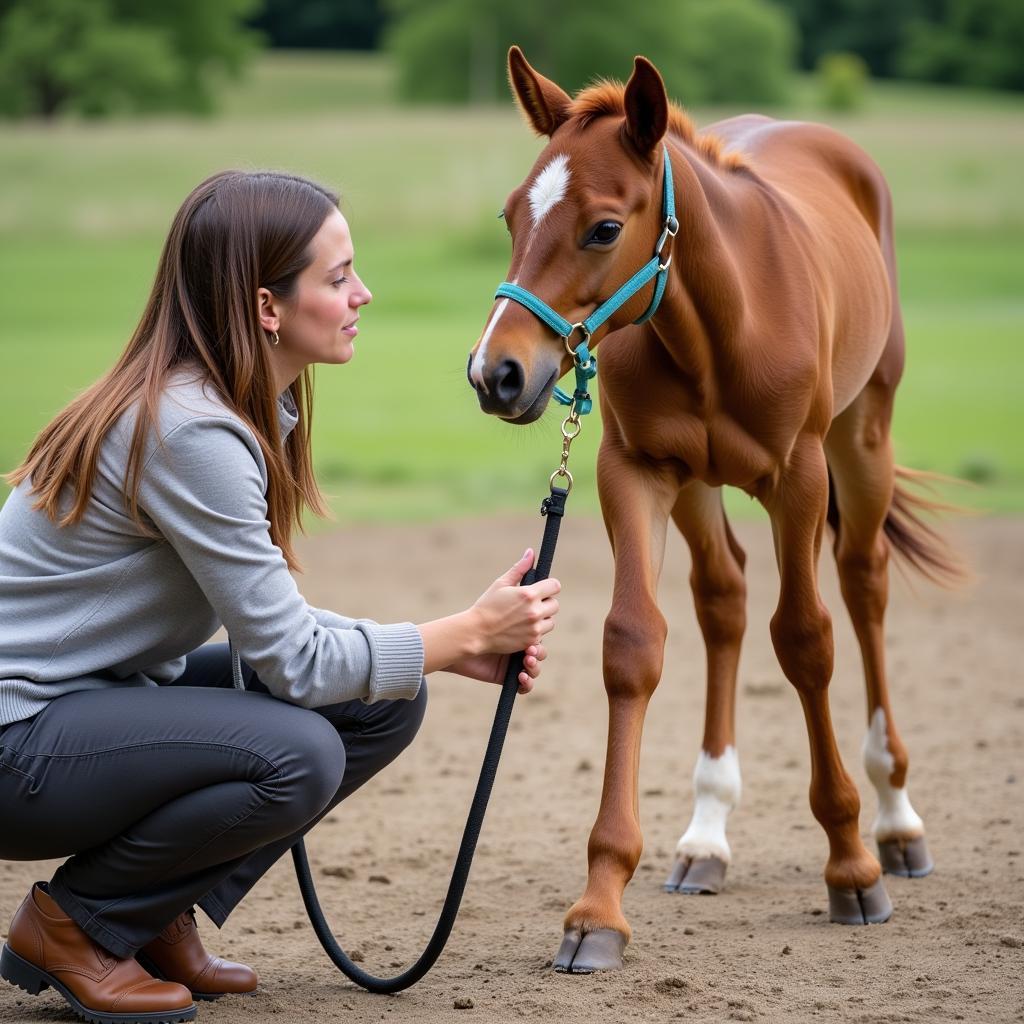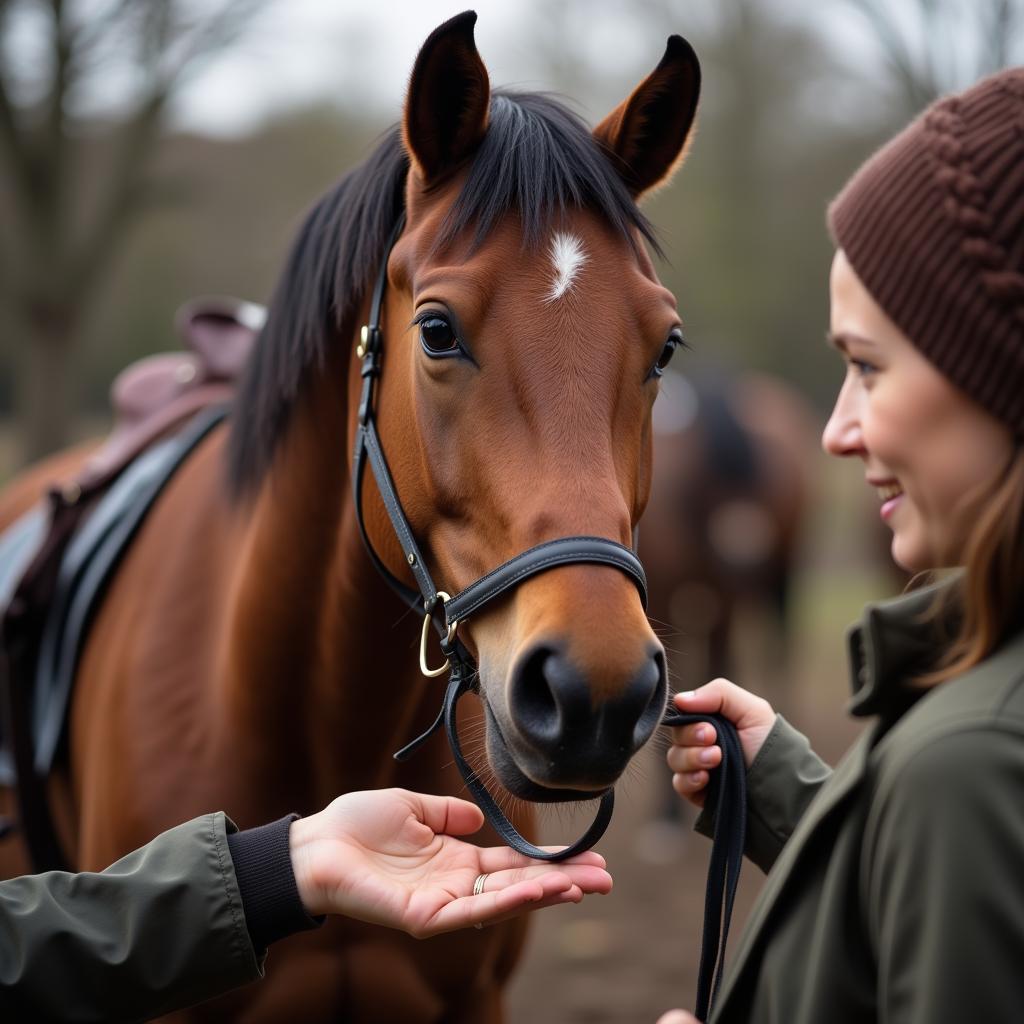Halter Breaking Horses is a fundamental step in their training, laying the groundwork for a safe and rewarding partnership. This crucial process involves accustoming a horse to the feel and pressure of a halter and teaching them to respond to gentle leading. It’s a process that requires patience, understanding, and a deep respect for the horse’s natural instincts. It sets the stage for future training and establishes clear communication between horse and handler.
Understanding the Importance of Halter Breaking
Halter breaking isn’t just about getting a horse to wear a halter; it’s about building trust and establishing leadership. A properly halter-broken horse is easier to handle, groom, transport, and train for other disciplines. It’s the first step towards creating a well-mannered and responsive equine partner. This early training also helps to desensitize the horse to human touch and handling, preparing them for future veterinary care and farrier visits. This foundation is essential for building a strong bond with your horse. For more insights on gentling horses, check out our resources on taming the wild horse.
A Step-by-Step Guide to Halter Breaking Horses
- Introducing the Halter: Begin by gently stroking the horse’s head and neck, gradually working your way towards placing the halter on. Let the horse sniff and investigate the halter.
- Securing the Halter: Once the horse is comfortable, carefully slip the halter over their nose and fasten the buckle. Ensure the halter fits snugly but not too tight.
- Initial Leading: Attach a lead rope to the halter and apply gentle pressure. Encourage the horse to follow you by using soft vocal cues and body language. Reward even the smallest steps forward with praise and gentle stroking.
- Practicing Leading: Start with short, controlled leading sessions in a safe, enclosed area. Gradually increase the duration and distance as the horse becomes more confident.
- Reinforcing Positive Behavior: Consistency is key. Reward the horse with praise, petting, or a small treat every time they respond correctly to your leading cues.
- Addressing Resistance: If the horse resists, avoid pulling or jerking the lead rope. Instead, maintain gentle pressure and patiently wait for them to yield. Once they do, release the pressure immediately as a reward.
- Building Trust and Confidence: Remember that halter breaking is a process that requires patience and understanding. Building trust with your horse is crucial for success.
 Halter Breaking a Young Horse
Halter Breaking a Young Horse
Looking for suitable halters for transportation? We offer a selection of shipping halters for horses.
Common Challenges in Halter Breaking
Horses, especially young or unhandled ones, may exhibit some resistance during halter breaking. Understanding these challenges can help you navigate them effectively. Some horses may initially be fearful of the halter and try to pull away. Others might be more stubborn and refuse to move. Patience and a calm demeanor are essential in overcoming these hurdles.
Dealing with a Fearful Horse
A fearful horse may require extra time and patience. Start by desensitizing them to the halter by allowing them to sniff and investigate it. Approach slowly and gently, using soft vocal cues and reassuring strokes.
 Working with a Fearful Horse During Halter Breaking
Working with a Fearful Horse During Halter Breaking
For horses that are particularly quiet, we have specific guidance on breaking the quite horse.
Handling a Stubborn Horse
With a stubborn horse, persistence and consistent pressure are key. Maintain gentle but firm pressure on the lead rope, rewarding even the slightest give. Avoid pulling or jerking, as this can escalate the resistance.
Halter Breaking and Beyond
Halter breaking is just the beginning of your horse’s training journey. It opens doors to countless other learning opportunities, from basic ground manners to advanced riding skills. A well-halter-broken horse is a pleasure to work with, forming the foundation of a strong and lasting bond.
“Patience is paramount when halter breaking. It’s not a race; it’s a journey of building trust and understanding.” – Dr. Emily Carter, Equine Behaviorist
Conclusion
Halter breaking horses is a cornerstone of equine training, setting the stage for a lifetime of partnership and learning. By approaching this process with patience, understanding, and a commitment to building trust, you can lay the groundwork for a safe, rewarding, and fulfilling relationship with your horse. Thinking about adding a miniature horse to your stable? Check out our resources on free miniature horses.
“Remember, halter breaking is about more than just getting a horse to wear a halter. It’s about establishing clear communication and building a foundation of respect.” – John Riley, Horse Trainer
FAQ
- How long does halter breaking typically take? It varies depending on the horse, but it can take anywhere from a few days to a few weeks.
- What age should you start halter breaking a horse? It’s best to start when they are young, ideally as foals, but older horses can also be halter broken.
- What type of halter is best for halter breaking? A well-fitting, adjustable nylon halter is generally recommended.
- What should you do if the horse pulls back during halter breaking? Maintain gentle pressure and wait for them to yield. Avoid jerking or pulling hard.
- How can you make halter breaking a positive experience for the horse? Use positive reinforcement, such as praise, petting, and treats.
- What are some common mistakes to avoid during halter breaking? Being impatient, using excessive force, and not rewarding positive behavior.
- When should I seek professional help with halter breaking? If you are experiencing significant difficulties or feel unsafe, consult a qualified horse trainer.
Other Questions We Often Get
- How do I transition from halter breaking to leading training?
- What are the signs of a well-halter-broken horse?
- Can I halter break a horse on my own, or should I seek professional help?
For further information on horse care and training, explore our other articles on horse tack hooks.
When you need assistance, please contact us: Phone: 0772127271, Email: [email protected], or visit our address: QGM2+WX2, Vị Trung, Vị Thuỷ, Hậu Giang, Việt Nam. We have a 24/7 customer service team ready to help.